3bolt79
Moderator
- Joined
- Jun 28, 2024
- Messages
- 482
- Reaction score
- 922
Well, I thought I would post this here as I know you guys probably haven’t seen inside of a real one before. If you break a string on one of these during a performance you’re basically screwed, as you have to disassemble the bar and remove the cover to change the string. You would also have to fish out the ball end from the cavity.
I gave her a bit of a face lift as I buffed out the whole guitar, and then applied swirl remover and buffed it out again followed by a hand applied polish. I have not tended to this guitar, other than to change strings in the last 11 or 12 years since I acquired it. It hasn’t needed a truss rod adjustment since the initial setup when I got it.
Here she is before I started last night.
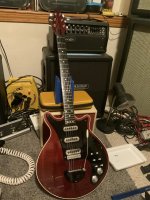
It had a lot of swirls and scratches from playing it over the last dozen or so years. I’m getting a little wear on the 2nd fret under the G string. You play a lot of A and D chords at the 2nd fret playing Queen songs.
Here’s what she looks like under the hood…

The two screws below the middle pickup hold the neck onto the front of the body. I snugged them up. There is also a single dime store, 11 mm nut that tightens from the back at the neck heel to a bolt that goes from the backside of the front of the neck, around the area below the end of the fingerboard toward the 21st fret.
The pickups are mounted directly to the body via tiny screws, and there are stacks of brass washers underneath the pickups where the screws go into the wood to act as spacers to adjust the heights of the pickups. I removed one from each side under the neck pickup to try to get the screws a little deeper into the wood, and added a piece of a tooth pick to each hole as the screws had vibrated almost all the way out.
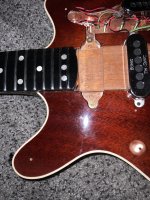
If you refer to the previous picture, yo will see that the neck actually extends well below the area of the middle pickup. The pickups are actually real Tri Sonics that were made on their original winding machines, using real parts, by a guy in the UK that had bought their old machines and parts after they Burns went out of business.
The guy in the UK is still making pickups, but a couple of years after he was making these pickups with the proper Burns covers, Burns was back in business. As a result of that, he can no longer sell pickups with covers that say Burns Tri-Sonics on them. So now, if you get the real deal pickups, the covers are blank. If I recall correctly, the same guy made the pickups for the run of 50 hand signed Brian May replica guitars made my Andrew Guyton many years ago.
There was a guy that was a member over at Strat Talk that had the only left handed Guyton Replica that was made. Unfortunately he wound up needing to sell it. It was hand signed by Dr./Sir Brian on the headstock. That guitar was around 10K USD when it was released, maybe more as it was the only lefty of the run. Mine was made by John Page and Everett Wood, both former Fender Custom Shop employees.
Wood had a company called Red Special Custom Guitars and they not only made these, but also replicas of the Guild 1984 Brian May models and offered all of his models in custom colors with custom wood options.
My guitar sold for $6500.00 when it was first released new. The only difference between mine, and the other model that he was making at the time is that mine is made of real Mahogany and Ebony instead of Pine block board and White Oak with veneers over the block board.
The potentiometers in the guitar are Soviet era 300 something K Ohms with long plastic shafts with brass collars for the stereo knobs to mount on with Allen key set screws.
Here’s some pics of the guitar with the swirl remover drying on the front and back before the second buffing.
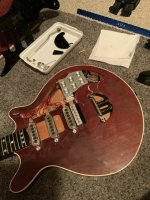

Below is the tremolo cavity. Yes ladies and gentleman, those are real motorcycle valve springs, from a 58 Norton I believe.
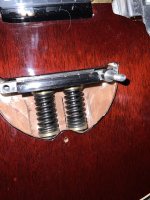
You adjust the compression of the springs via a hole on either side of the strap button. I use a Fender T-handle truss rod tool for this purpose. It’s the only thing long enough to reach the adjustment at the bottom of the springs from the outside of the body.
And here she is all done.
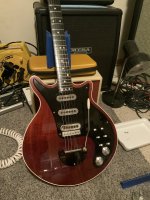
I will need to get some tuner buttons from Grover when I get paid next month, as five of the six buttons are cracked all the way through. They are cheap, pearloid plastic.
I gave her a bit of a face lift as I buffed out the whole guitar, and then applied swirl remover and buffed it out again followed by a hand applied polish. I have not tended to this guitar, other than to change strings in the last 11 or 12 years since I acquired it. It hasn’t needed a truss rod adjustment since the initial setup when I got it.
Here she is before I started last night.

It had a lot of swirls and scratches from playing it over the last dozen or so years. I’m getting a little wear on the 2nd fret under the G string. You play a lot of A and D chords at the 2nd fret playing Queen songs.
Here’s what she looks like under the hood…

The two screws below the middle pickup hold the neck onto the front of the body. I snugged them up. There is also a single dime store, 11 mm nut that tightens from the back at the neck heel to a bolt that goes from the backside of the front of the neck, around the area below the end of the fingerboard toward the 21st fret.
The pickups are mounted directly to the body via tiny screws, and there are stacks of brass washers underneath the pickups where the screws go into the wood to act as spacers to adjust the heights of the pickups. I removed one from each side under the neck pickup to try to get the screws a little deeper into the wood, and added a piece of a tooth pick to each hole as the screws had vibrated almost all the way out.

If you refer to the previous picture, yo will see that the neck actually extends well below the area of the middle pickup. The pickups are actually real Tri Sonics that were made on their original winding machines, using real parts, by a guy in the UK that had bought their old machines and parts after they Burns went out of business.
The guy in the UK is still making pickups, but a couple of years after he was making these pickups with the proper Burns covers, Burns was back in business. As a result of that, he can no longer sell pickups with covers that say Burns Tri-Sonics on them. So now, if you get the real deal pickups, the covers are blank. If I recall correctly, the same guy made the pickups for the run of 50 hand signed Brian May replica guitars made my Andrew Guyton many years ago.
There was a guy that was a member over at Strat Talk that had the only left handed Guyton Replica that was made. Unfortunately he wound up needing to sell it. It was hand signed by Dr./Sir Brian on the headstock. That guitar was around 10K USD when it was released, maybe more as it was the only lefty of the run. Mine was made by John Page and Everett Wood, both former Fender Custom Shop employees.
Wood had a company called Red Special Custom Guitars and they not only made these, but also replicas of the Guild 1984 Brian May models and offered all of his models in custom colors with custom wood options.
My guitar sold for $6500.00 when it was first released new. The only difference between mine, and the other model that he was making at the time is that mine is made of real Mahogany and Ebony instead of Pine block board and White Oak with veneers over the block board.
The potentiometers in the guitar are Soviet era 300 something K Ohms with long plastic shafts with brass collars for the stereo knobs to mount on with Allen key set screws.
Here’s some pics of the guitar with the swirl remover drying on the front and back before the second buffing.


Below is the tremolo cavity. Yes ladies and gentleman, those are real motorcycle valve springs, from a 58 Norton I believe.

You adjust the compression of the springs via a hole on either side of the strap button. I use a Fender T-handle truss rod tool for this purpose. It’s the only thing long enough to reach the adjustment at the bottom of the springs from the outside of the body.
And here she is all done.

I will need to get some tuner buttons from Grover when I get paid next month, as five of the six buttons are cracked all the way through. They are cheap, pearloid plastic.
Last edited: